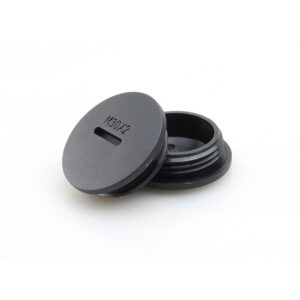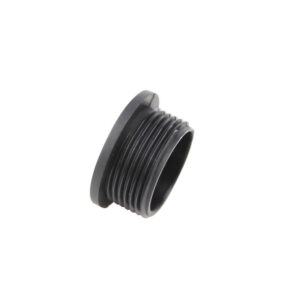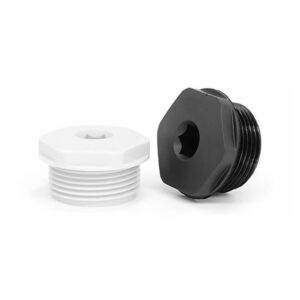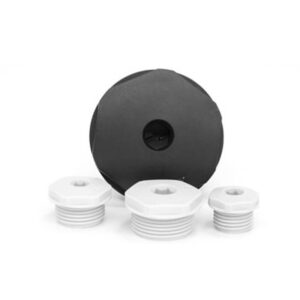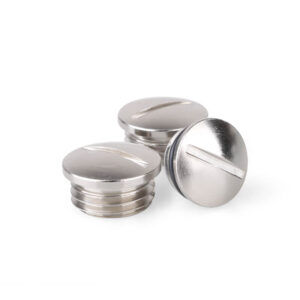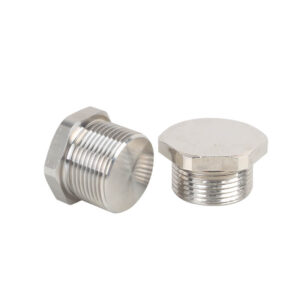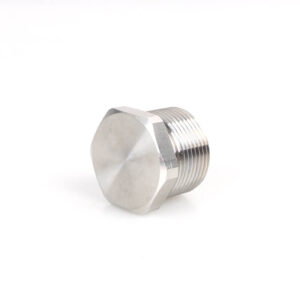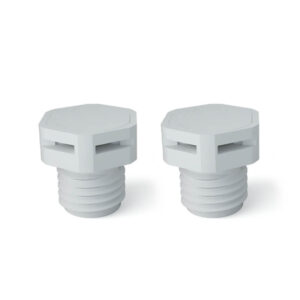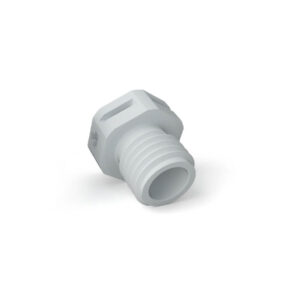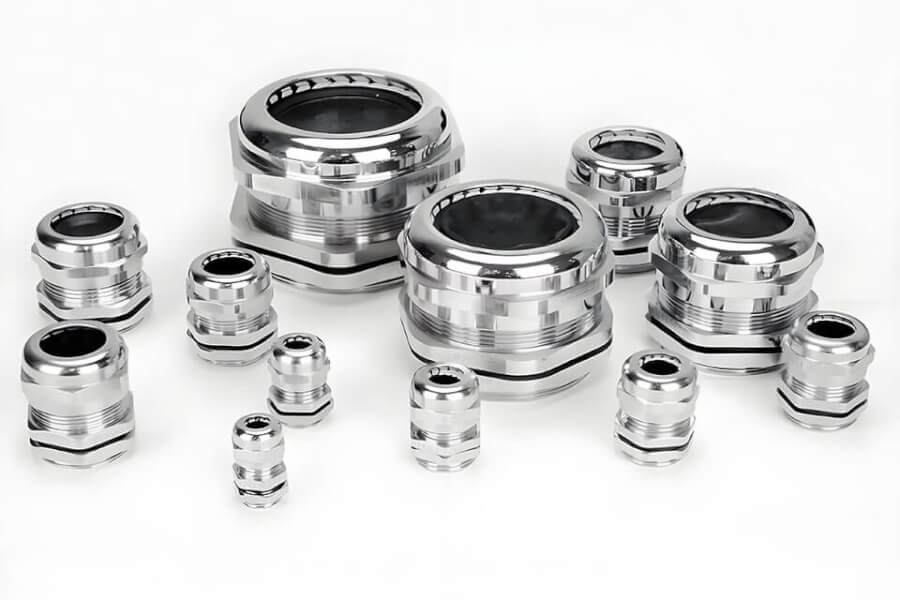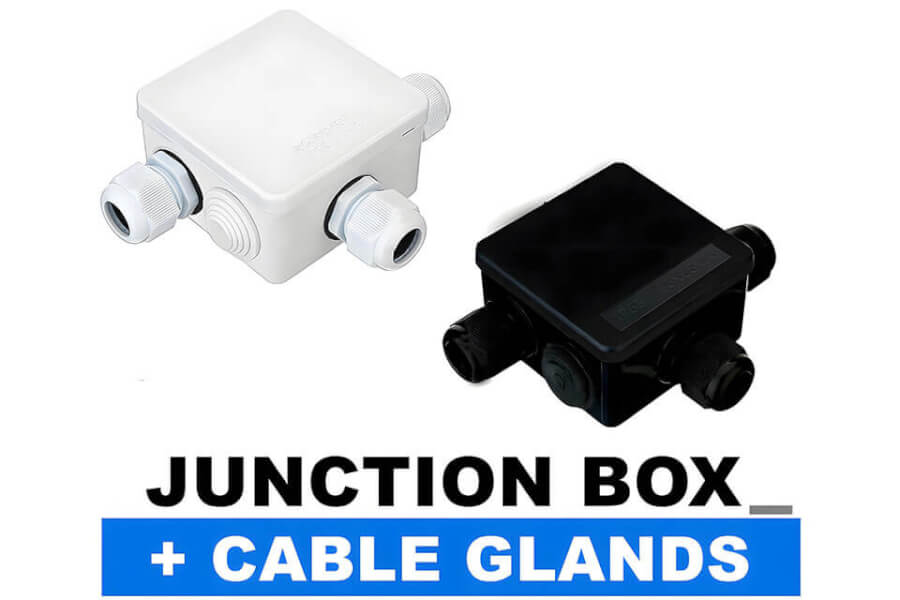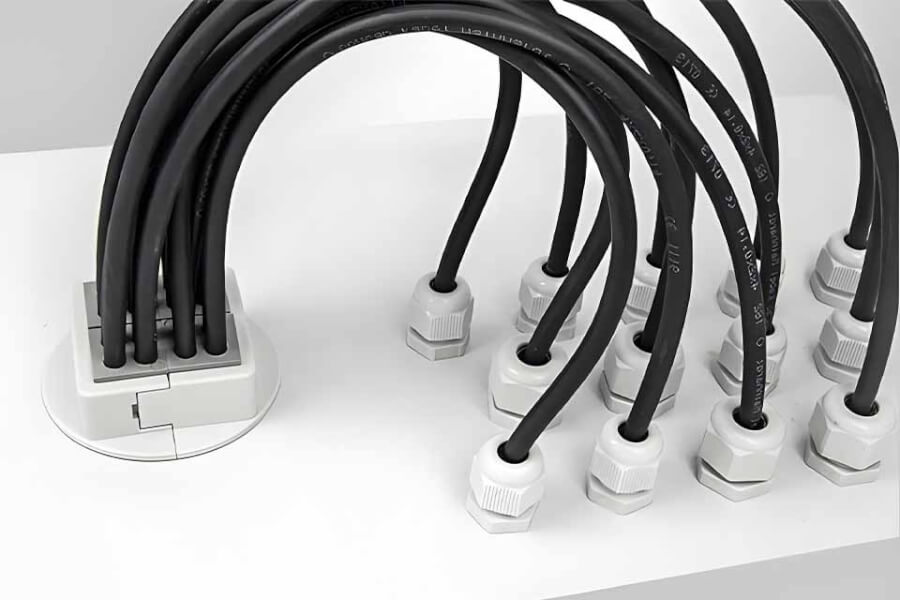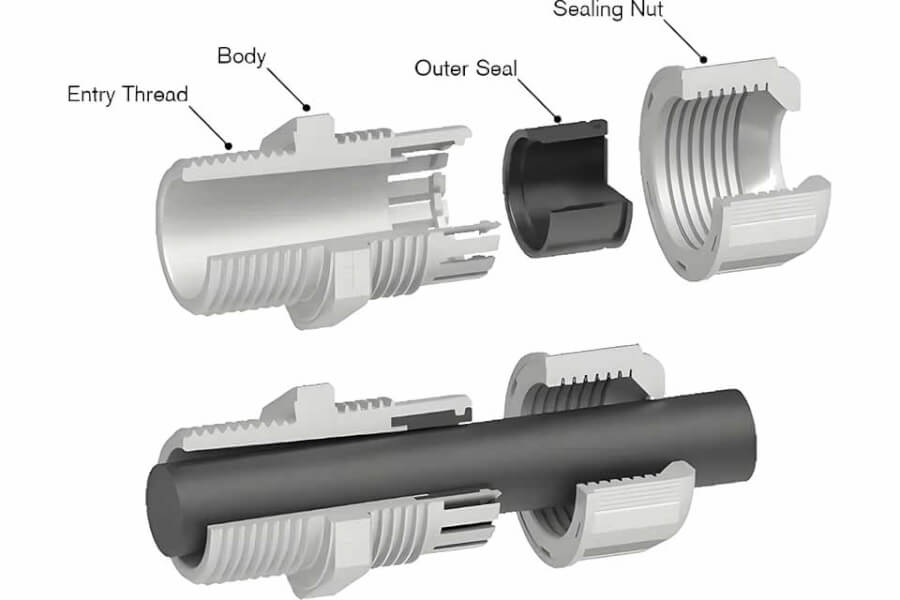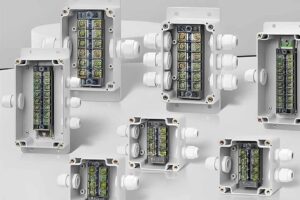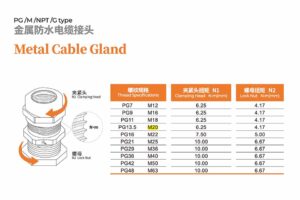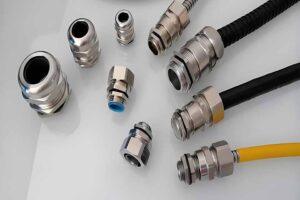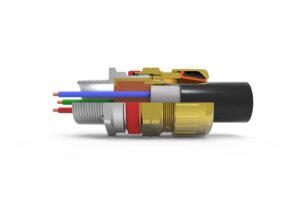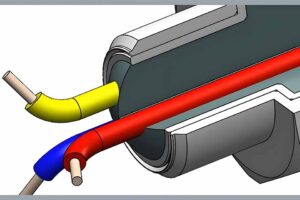目次
ケーブルグランドのサイズの測り方:完璧なフィットのための簡単なステップ・バイ・ステップ・ガイド
正しい選択 ケーブルグランド サイズは簡単そうに見える。しかし、そうだろうか?それを間違えると、大きな問題が起こる可能性がある。ワイヤーが緩む。水が漏れる。ホコリによるショート。機械が動かなくなる。これにはお金と時間がかかります。危険でさえあります!
サイズを推測するのに疲れていませんか?水漏れや破損が心配ですか?接続不良の修理に時間をかけすぎていませんか?小さな部品が大きなトラブルを引き起こすのは頭痛の種です。あなたの高価な機器が、その部品のために故障することを想像してみてください。 ケーブルグランド それは正しくなかった。もっと悪いのは、誰かが怪我をすることだ。この心配は、電気設備を扱う多くの人にとって現実的なものだ。
でも心配しないで!簡単な方法があります。このガイドでは ケーブルグランドのサイズの決め方 毎回毎回。そして何だと思う?一流の ケーブルグランドメーカー 私たちは、完璧で安全な装着のために必要な部品を中国で製造しています。丈夫な 金属製防水ケーブルグランド信頼できる プラスチック製防水ケーブルグランド便利 多穴ケーブルグランドそして安全 ジャンクションボックス.丈夫に作られているので、接続は安全でドライなままです。このガイドに従って、安心して当社のグランドをお選びください。
1.ケーブル・グランドのサイズを正しくすることが超重要な理由
を考えてみよう。 ケーブルグランド ワイヤーの小さな門番のようなものだ。重要な仕事をしてくれる:
- ケーブルをしっかりホールド: ケーブルが引っ張られたりねじれたりするのを防ぎます。これにより、内部の接続部にストレスがかかるのを防ぎます。グランドが緩すぎると、ケーブルが滑ることがあります。グランドがきつすぎると、ケーブルがつぶれてしまいます。
- 物が入らないようにする: ケーブルがボックスや機械に入る穴を密閉する。これにより、水、ほこり、汚れ、虫などが内部に侵入するのを防ぎます。サイズが合わないと密閉性が悪くなります。水漏れが起こります。
- 安全第一: 優れた密閉性は、危険なエリアでの火花の流出を防ぐ。また、水による短絡も防ぎます。正しいサイズ設定が電気安全規則の鍵です。
問題だ: 間違ったサイズの使用 ケーブルグランド 合わない靴を履いているようなものだ。それは痛みを引き起こす! 攪拌する: 高価なコントロールパネルに水が漏れているのを想像してみてください。錆が発生する。配線は腐食する。突然、システム全体がシャットダウンする。修理には多額の費用がかかります。ダウンタイムはビジネスの損失を意味します。すべては、グランドが正しくシールされていなかったからです。あるいは、機械内部でケーブルが抜け、火花やショックの危険を引き起こすことを想像してください。これらは単なる小さなミスではなく、重大な安全上のリスクなのです。 解決策 数分かけて正確に計測し ケーブルグランド選択ガイド は、このような悪夢を防ぎます。当社が製造しているような高品質のグランドを使用することで、密閉度が高く、長持ちします。当社のグランドは、ケーブルのサイズに合わせて正確に作られており、必要な保護を提供します。
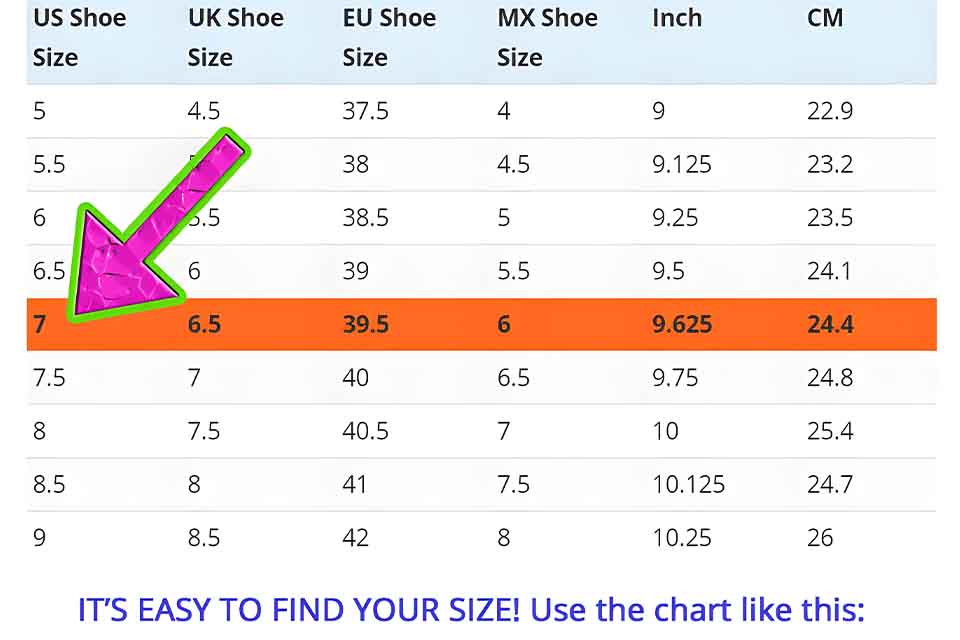
2.ケーブル・グランドの種類は?
すべてのケーブルや仕事が同じではありません。ですから ケーブルグランド.種類を知ることで、適切なものを選ぶことができる 以前 あなたはサイズを気にする。
- 素材に基づく:
- メタル・グランド 超強力!頑丈な場所に最適。真鍮、ステンレス、アルミ製が多い。工場や屋外に最適。私たちの 金属製防水ケーブルグランド は過酷な条件下でも長持ちするように作られている。
- プラスチック(ナイロン)グランド 軽量。錆びない。安価であることが多い。一般的な使用、特に屋内や化学薬品が金属を腐食させる可能性のある場所での使用に適している。私たちの プラスチック製防水ケーブルグランド は、多くの用途で信頼性の高いシーリングを提供します。
- ケーブル・タイプに基づく:
- 非装甲ケーブル用グランド: 絶縁体とシースだけの標準的なケーブルです。ほとんどのプラスチック・グランドとシンプルな金属グランドがここで機能する。
- アーマード・ケーブル用グランド: アーマード・ケーブルは、金属層(スチールワイヤーアーマーのようなもの:SWA)で保護されている。アーマーをグリップする特殊なグランドが必要 そして ケーブルを密閉する。 アーマードケーブルグランドのサイジング は非常に重要である。ここでは二重圧縮腺がよく使われる。
- 特徴に基づく:
- 防水グランド: 水が入らないようにシール(ゴムリングのようなもの)が付いている。IPコードで評価されています(IP68は非常に防水性が高いことを意味します)。当社の金属製とプラスチック製のグランドは、どちらも優れた防水オプションを提供します。
- 防爆型グランド: 爆発する恐れのあるガスや粉塵のある危険な場所用。非常に厳しい安全規則が適用されます。
- 多穴ケーブルグランド:1つのグランド開口部から複数のケーブルを通すことができます。スペースを節約します!弊社はこの便利なスペースセーバーを製造しています。
- ストレイン・リリーフ・グランド ケーブルが鋭く曲がったり、引っ張られたりしないように設計されている。
問題だ: 間違った選択 タイプ 大きさは問題なくても、腺はうまく機能しない。 攪拌する: 屋外で重い装甲ケーブルに単純なプラスチック製のグランドを使うことを考えてみてください。装甲をうまくグリップできません。ケーブルが抜ける可能性がある。装甲の周囲に水が浸入する。接続はすぐに失敗する。時間とお金を無駄にした。 解決策 ケーブルの種類(装甲ケーブルかどうか)、使用場所(濡れた場所か、埃っぽい場所か、危険な場所か)を把握する。そして、適切な タイプ グランド強靭な金属製、汎用性の高いプラスチック製、多穴タイプなど、お客様のニーズに合わせて様々なタイプをご用意しています。
3.完璧なケーブルグランドサイジングのための簡単なステップ
さて、本題に入ろう!あなたの ケーブルグランド.以下のステップに従えば、思ったより簡単だ。
ステップ1:ケーブルの外径サイズを調べる
- これは 最重要 測定!必要なのは 総厚 ケーブルの外端から外端まで。
- 使用しないでください。 ケーブルの電気サイズ(2.5mm²や10AWGなど)。この数字は、全体の厚さではなく、内部の銅の厚さを示しています。サプライヤーに「4×1.5 mm² のケーブルがある」と言えば、「ケーブルの太さは? 外径?”
- ケーブル外径の測定方法: 最良の結果を得るにはノギスを使用する。ノギスがない場合は、ケーブル・メーカーのデータ・シート をチェックする。通常、外径(「全 外径」またはODと呼ばれることもある)が記載されている。
ステップ2:ケーブルが装甲されているか確認する
- ケーブルをよく見てください。外側のプラスチックカバーの下に金属層がありますか?それがアーマー(鋼線や金属テープのようなもの)です。
- はい」の場合は、必ず 装甲ケーブルグランド.直径も必要です。 オーバー アーマー(アーマーの下に層がある場合、「ベッディング上の直径」と呼ばれることもある)の上にある。これはグランドがアーマーを正しくグリップするのを助ける。 アーマードケーブルグランドのサイジング このディテールが必要なのだ。
- アーマーがない場合は、標準的な(アーマーなしの)グランドを使用する。
ステップ3:ケーブルグランドサイズ表を使う
- これはあなたの強い味方です!私たちのようなメーカーは、ケーブルのサイズとグランドのサイズを一致させるチャートを提供しています。あなたは ケーブルグランドサイズチャート オンラインまたはカタログで。
チャートの仕組み
- ケーブルの 外径 をチャート上に表示した。
- チャートによっては コア数 (内部のワイヤー)。ケーブルのコアの行/列を探す。
- 外径とコア数が一致するところでは、チャートは右のようになります。 ケーブルグランド サイズ。これはメートルねじサイズ(M20、M25など)かもしれないし、別のタイプ(PGやNPTなど)かもしれない。
- アーマード・ケーブルの場合、チャートにはアーマード直径の範囲に余分な列があるかもしれません。その場合は ダブル・コンプレッション・グランド・チャート 装甲タイプに必要であれば。
データからの例
| Cable Outer Diameter (Approx) | Number of Cores | Gland Size (Metric) | Cable Type Example | | :—————————- | :—————- | :—————— | :———————- | | 10 mm | 2-4 | M16 | Small control cable | | 13 mm | 4 | M20 | 4-core 1.5mm² power | | 17 mm | 4 | M25 | 4芯10mm²パワー | [^4][^6]の例|28mm|12|M40|多芯装甲|50mm|48|M75|工業用大型フィーダー (注:これは簡略化した例です。選択するグランドについては、必ず特定のメーカーのチャートを使用すること)
ステップ4:クイックチェック(ドライフィット)
- すべてを締め上げる前に、グランドをケーブルにスライドさせる。
- ケーブルはグランドの穴に簡単に収まりますか?良好です。
- グランドのシールは、締め付けたときに外側のシースをぴったりとつかむように見えますか?良い。(アーマード・グランドの場合は、アーマー・グリップもチェックする)。
- もし、ゆるすぎたり、きつすぎたりするようであれば、サイズを再確認してください。 ケーブルグランドサイズチャート.
問題だ: ただサイズを推測したり、間違った測定方法(mm²など)を使ったりすると、失敗につながる。 攪拌する: 何十個もグランドを取り付けたのに、最初の雨で漏水していることに気づく!あるいは、小さすぎるグランドにケーブルを無理やり押し込むのに苦労し、ケーブル・シースを傷つけてしまうことを想像してみてください。イライラさせられ、貴重な時間と材料を浪費する。 解決策 以下の簡単な手順に従ってください!測定する 外径.アーマーをチェックする。を使用する。 ケーブルグランドサイズチャート.クイックドライフィットを行う。一瞬で済みますが、何時間も悩む必要はありません。製造業者として、私たちは明確なチャートと正確なサイズで作られたグランドを提供し、このプロセスをスムーズにします。私たちの目標は、お客様の安全な取り付けを成功させることです。

4.サイズ調整に役立つツールとチャート
適切な工具があれば、どんな仕事も簡単になります。ケーブルグランドのサイジングも同じです。
- 必携ツールノギス
- これが最善の方法だ。 ケーブルの外径を測る 正確に。デジタルノギスは読みやすい。バーニアキャリパーも効果的です。巻き尺は当てにならない。
- あなたのための情報源メーカーケーブルグランドサイズチャート
- のメーカーのチャートを常に使用すること。 ケーブルグランド をご使用ください。サイズはブランドによって若干異なる場合があります。
- に特化したチャートを探す。 タイプ のグランド(金属、プラスチック、装甲、二重圧縮)が必要です。グランドは ダブル・コンプレッション・グランド・チャート それらの特定の腺のために。
- 金属製、プラスチック製、マルチホールのすべてのグランドについて、詳細なチャートを提供し、選択を容易にしています。
- 役立つおまけオンライン計算機&ガイド
- ケーブルの詳細を入力すると、グランドサイズを提案してくれる計算機もあります。これらは役に立ちますが、必ずメーカーの公式サイトと照らし合わせてください。 ケーブルグランドサイズチャート.
- あなたが読んでいるこの記事は ケーブルグランド選択ガイド!
問題だ: 当て推量や間違ったチャートに頼るとミスにつながる。 攪拌する: ビンの中から腺をつかむ。それは ルックス その通り。それを取り付ける。その後、ケーブルのIP等級やサイズが適切でなかったため、検査で不合格となる。この場合、作業をやり直さなければなりません。あるいは、ブランドYのグランドにブランドXのチャートを使う!ネジのサイズが違うかもしれません。 接続箱.さらに遅れる。 解決策 正しい道具を使う!ノギスを手に入れよう。ノギスを使え 正しい メーカーの ケーブルグランドサイズチャート 特定の腺のタイプに対応する。これらのチャートは、必要不可欠なガイドとしてお考えください。私たちのチャートは、正確でわかりやすいものです。 ケーブルグランド.
5.よくある間違い(そしてそれをしない方法)
プロでも時々失敗します。ここでは、ケーブルグランドのサイズを決める際によくある間違いを紹介します:
- 間違い1:外径の代わりに電気サイズ(mm²/AWG)を使う。
- 前にも言ったが、#1のエラーだ!グランドシール 外側 ケーブルの
- 修正する: 常に ケーブルの外径を測る キャリパー付き
- 間違い2:ケーブルアーマーを無視する。
- アーマード・ケーブルに標準的なグランドを使用することは、アーマーがグリップされていないことを意味する。グランドが抜け、シールが失敗する可能性がある。
- 修正する: ケーブルにアーマーがある場合は、以下の目的で設計されたグランドを使用してください。 アーマードケーブルグランドのサイジング (二重圧縮グランドのようなもの)。をチェックする。 ダブル・コンプレッション・グランド・チャート.
- 間違い3:スレッドの種類を混ぜる。
- グランドには、機器にねじ込むためのネジ山がある。 接続箱).一般的なタイプは、メートル(M)、PG、NPTです。これらは互換性がありません!M20のグランドはPG13の穴には合いません。
- 修正する: ご使用の機器に必要なスレッドタイプをご確認ください。 以前 グランドを選択する。グランドのネジの種類とサイズがエントリーホールに合っていることを確認してください。
- 間違い4:シーリング範囲をチェックしない。
- ほとんどの場合 ケーブルグランドサイズチャート 表示する 範囲 例えば、M20は外径10mmから14mmのケーブルに適合します。
- 修正する: ケーブルの外径が快適に収まることを確認する。 内 そのグランド・サイズのチャートに示されたシーリング範囲内で使用してください。できる限りギリギリにならないようにしてください。
- 間違い5:見た目で推測する。
- 2つのグランドが似ていても、シーリング範囲やネジサイズが異なる場合があります。
- 修正する: 推測は禁物です!必ず部品番号とメーカーの ケーブルグランドサイズチャート.
問題だ: こうした単純なミスが、水漏れや故障、安全性の問題といった大きな頭痛の種を引き起こす。 攪拌する: 締め切りが迫っている。あなたはこのようなミスを犯した。作業を中断し、正しい部品を注文し、納品を待って、取り付けをやり直さなければならない。プロジェクトは遅れる。上司は不機嫌になる。顧客は不幸になる。小さな見落としがこのような大きな問題を引き起こすと、ひどい気分になる。 解決策 これらの罠を避けよう!常に測定する 外径.防具を識別する。正しい ケーブルグランドサイズチャート とシール範囲を確認する。ネジの種類を合わせる。このような慎重なステップを踏むことで、初回からスムーズで正しい取り付けが可能になります。メーカーとしての当社の品質管理は、当社のグランドが正確なサイズ仕様に適合していることを意味し、当社のチャートを使用する際のエラーの可能性を低減します。
6.トリッキーな状況に対する特別なヒント
時には、よりタフな仕事のためにグランドが必要な場合もあります。選び方は以下の通り:
- 爆発する可能性のある場所(危険区域)用:
- あなた マスト 特殊な "Ex "定格のグランド(ATEXまたはIECEx認証のような)を使用してください。ここでは安全性が重要です。
- グリップ力と密閉性を高めるため、多くの場合、二重圧縮設計が採用されている。フォロー アーマードケーブルグランドのサイジング ここでアーマード・ケーブルを使用する場合は、慎重にルールを守ること。
- 揺れの多い(振動の多い)場所に:
- 機械や乗り物、モーターの近くを考えてみてほしい。
- 振動用に設計されたグランドを使用する。 二重圧縮腺 この場合、2箇所でケーブルをグリップするため、金属グランドの方が優れていることが多い。メタル・グランドは通常、プラスチックよりも丈夫である。
- 濡れた場所、雨の多い場所、水中での使用に:
- IP保護等級(Ingress Protection)が高いことを確認すること。IP67は防塵で、短時間の水没が可能。IP68は防塵を意味し、より長く、より深く水に浸かることができる(メーカーの仕様を確認すること)。IP69Kは高圧、高温の洗浄用。
- 私たちの 金属製防水ケーブルグランド (特にステンレス鋼)と高品質の プラスチック製防水ケーブルグランド は湿気の多い場所用に設計されています。腐食性の強い場所(海水の近くなど)には、ステンレススチールや特殊プラスチックを選ぶ。
- 一箇所に複数のケーブルを収納可能:
- を使用する。 マルチホールケーブルグランド.多くの穴を開けるよりもスペースを節約でき、見た目もすっきりする。
- 各ケーブルが、グランド・インサートの穴にぴったりと収まっていることを確認してください。
問題だ: 困難な場所で標準的なグランドを使うと、すぐに故障につながる。 攪拌する: 振動するポンプに標準的なプラスチック製グランドを取り付けることを想像してみてください。振動ですぐに緩んでしまう。ホコリとオイルが内部に侵入する。ポンプモーターがショートする。あるいは、低いIP定格のグランドを屋外で使用すると、最初の大雨の際に漏水し、接続された内部の電子機器が台無しになります。 接続箱.このような不具合は、誤ったグランドタイプを選択した場合に予測できる。 解決策 グランドを作業に合わせます!危険エリアには防爆グランド、振動には堅牢なメタルまたはダブルコンプレッショングランド、ウェットスポットには高IP規格のグランド、そしてスペースを節約するにはマルチホールグランドを使用します。製造業者として、当社はこれらの厳しい状況用に特別に設計されたグランドを提供し、最も必要な場所で信頼性を確保します。

7.クイックアンサーケーブルグランドに関するFAQ
よくある質問にお答えします:
- Q: ノギスがない場合、ケーブルの外径はどのように測ればよいですか?
- A: 最良の方法はノギスです。それができない場合は、ケーブル・リールのラベルやメーカーのウェブサイトでケーブルの仕様書を確認する。公称外径が記載されているはずです。糸で巻こうとしても、正確さに欠ける。
- Q: PG穴にメートル(M)グランドを使用できますか?
- A: ネジ山が違うんだ。正しくねじ込めない。ネジの種類(M、PG、NPT)を正確に合わせる必要があります。
- Q: ケーブル径が2つのグランド・サイズのちょうど中間にある場合はどうなりますか?
- A: の両グランド・サイズのシール範囲を確認してください。 ケーブルグランドサイズチャート.ケーブル径がギリギリではなく、その中間に収まるサイズを選ぶ。不安な場合は、少し大きめのサイズを選ぶとよいでしょう。 もし しかし、メーカーのアドバイスを確認してください。
- Q: ケーブルの温度はグランドのサイジングに影響しますか?
- A: 猛暑または極寒 缶 ケーブル素材をわずかに膨張または収縮させる。より重要なことは、グランドを選ぶことです。 材料 (金属、プラスチックの種類)を使用する。サイズ自体は通常調整する必要はないが、素材の選択が鍵となる。
- Q:それは何ですか? ダブル・コンプレッション・グランド・チャート 標準的なチャートとは違うのですか?
- A: そう、よくあることだ。ダブルコンプレッション腺は、内側の寝具(アーマーの下)と外側のシースの両方をグリップします。チャートでは、特に以下の場合、両方の直径を考慮する必要があります。 アーマードケーブルグランドのサイジング.
- Q: 信頼できる会社はどこにありますか? ケーブルグランド選択ガイド?
- A: 信頼できるメーカーのウェブサイト(当社のような!)、電気サプライヤーのカタログ、業界標準の文書が良い情報源です。この記事も基本的なガイドとして役立ちます!
問題だ: 不確実性はためらいやミスにつながる。 攪拌する: あなたはケーブルと腺の箱を持って、どれが正しいのかわからずに立っている。推測するのか?作業を中断して情報を探すのか?このような不確実性は、時間を浪費し、疑念を生む。 解決策 明確な答えを得る正しいツールを使おうキャリパス)、適切なリソース(ケーブルグランドサイズチャート)、必要であれば質問をする。このような一般的な回答を知っておくことで、自信を持って手続きを進めることができます。私たちは、製品に関する明確な情報とサポートを提供することを目指しています。
8.結論安全で信頼できる接続にはサイズが重要
正しい選択 ケーブルグランド サイズは単なる小さなことではなく、安全性、信頼性、そして電気システムをスムーズに作動させるために極めて重要です。これを間違えると、問題につながります:
- 接続の緩み
- 水やほこりの侵入
- ケーブルの損傷
- 機器の故障
- 安全上の危険
問題の総括 間違ったサイズのグランド=漏れ、損傷、危険。 アジテーションの総括 接続の失敗によるコスト、ダウンタイム、安全上のリスクを想像してみてほしい。心配は尽きない。 ソリューションの総括 簡単な手順に従ってください: ケーブル外径の測定鎧を識別し、正しいメーカーを使用する ケーブルグランドサイズチャートそしてクイックフィットチェックを行う。簡単だ!
専属選手として ケーブルグランドメーカー 中国に拠点を置く当社は、適切なフィット感がいかに重要であるかを理解しています。だからこそ私たちは、高品質で正確なサイズの腺の生産に重点を置いているのです:
- 耐久性 金属製防水ケーブルグランド
- 多用途 プラスチック製防水ケーブルグランド
- 省スペース 多穴ケーブルグランド
- 信頼できる ジャンクションボックス をクリックしてインストールを完了します。
私たちは明確な ケーブルグランドサイズチャート とサポートで、毎回完璧な選択をサポートします。しっかりと密閉され、長持ちするグランドは、当社の製造力にお任せください。作る ケーブルグランドのサイズの決め方 このガイドを参考に、安心して高品質の腺を選んでください。
News & Blog
ケーブルグランドとは何か、なぜ重要なのか、そして正しい選択がどのようにケーブルを保護し、安全性を高め、どのような環境でも信頼できる性能を保証するのかをご覧ください。

